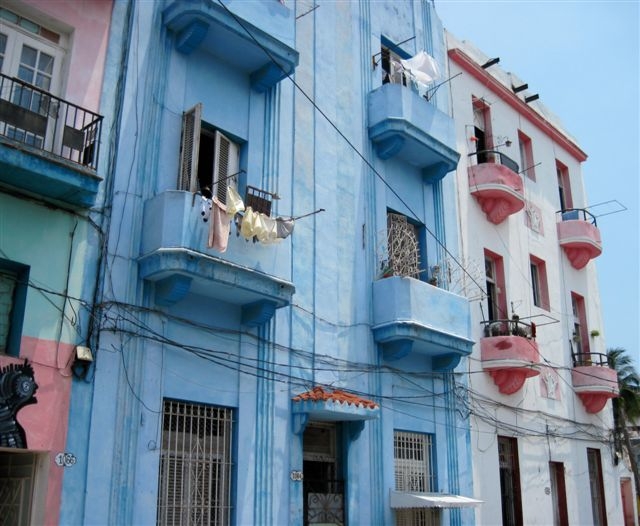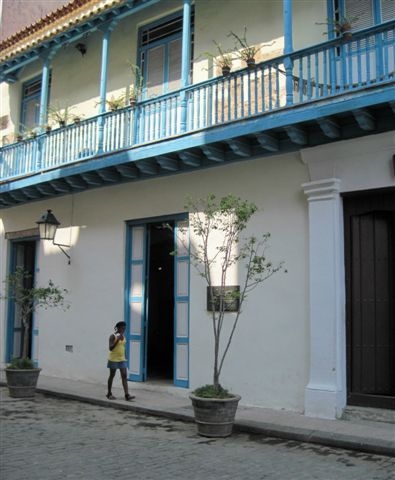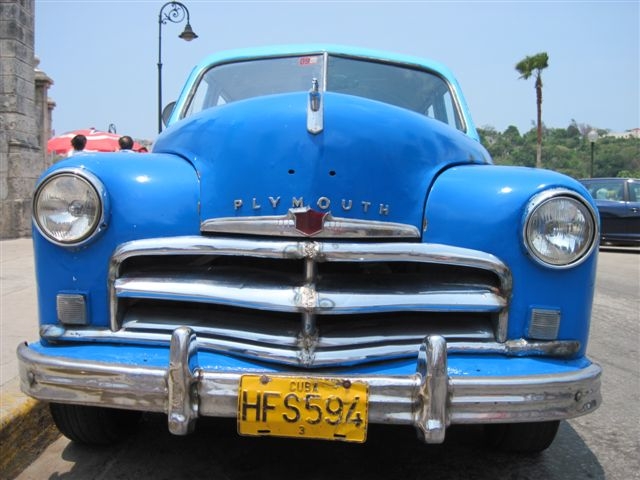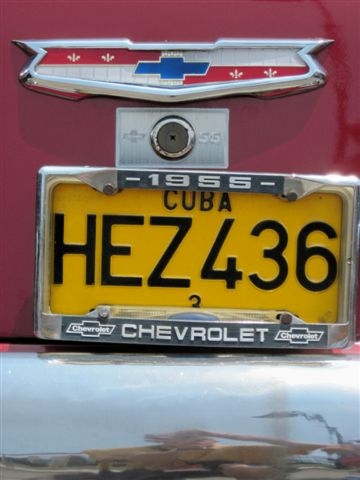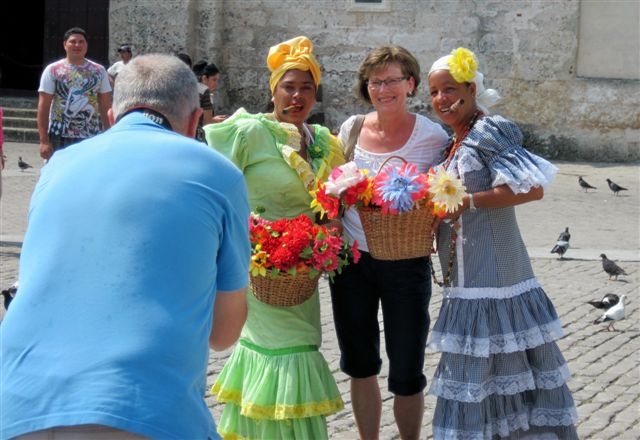Sometimes I am a voyager in time. I do not need a hotel for this, or a bag that's full of miniature mouthwash and shampoo. Memory is a landscape I can run to fairly easily -- and since we are talking travel, I will admit it: I go and go.
Recently, I climbed out of one of my 1960s daydreams, rubbed my eyes, and looked around. Let's see here, I thought. I am in a hotel that smells, just slightly, of cigars. Is that a radio over there? It is. A rotary phone is ringing just behind the desk, and someone's using a pencil -- the type you grind to a point -- to draw a line on my map.
The top of this unfolded grid of streets says "Havana," so I know that phone and radio and pencil are real. I am not in a reverie after all. It is day one of my mid-May Cuban music and art tour, a trip that's run by Insight Cuba and that requires I participate in a full, government-approved schedule of "educational" activities.
Along with the other tourists I am hoping for more than vibrant canvases and pulsating sounds. Havana's in the midst of a major art exhibition which showcases voices from Latin America and throughout the Third World. This is a fact. But, as Americans traveling here on one of the "People-to-People" exchanges started by President Clinton in 2000, we are eager to get a broader look at what life is like here.
After years of U.S. Treasury Department travel restrictions, Cuba has taken on an air of mystery. Our 45-minute charter-flight from Miami and the bus ride into Havana make us feel like astronauts of a sort, touching down for nine days in a parallel world.
"I've been planning this trip forever," says Mary Cowden of Kingsport, Tenn., as we walk with our group through the city's Plaza de Armas, Plaza Vieja and Plaza de la Catedral. Cowden shows me some plastic bags that are bulging with toiletries she's been stocking up on back in Tennessee. There are band aids, bars of soap, toothbrushes ("kids' size and adult") and reading glasses in a variety of styles.
"For the Cuban people," Cowden explains. "My friend said there are all types of needs. If you bring them the glasses, especially, you'll be Queen of Cuba." I don't say anything, but based on what I've seen so far, the stores seem pretty well stocked. Ice cream stands may have only two or three flavors, but there are scoops to sell.
As we walk, boys in sandals and shorts swing at baseballs in a cobbled square. Buildings are lemon yellow, lime green. If you could grip them, somehow, you could squeeze them into a drink. Along the edges of the old town there are some signs of stress. "See this?" says our Cuban guide, Alberto, aiming a finger at a concrete tower that is near the Malecón, the city's coastal promenade. "It is sick of cancer," he says. "The salt from the air of the ocean: it is giving it holes."
In his 70s, Alberto is tanned and wiry, and ready -- in his batter's stance -- for any sliders that a tourist might throw. "Si and no," he says to some of the more sensitive questions. "Yes and no." A longtime Cuban patriot, he blames the U.S. for bits of history on the island including "a plague of pig fever."
Since this is a cultural tour he finds us street musicians who are singing the vaguely mournful Cuban country music known as "son." He guides us to a park where there are booths set up with stacks of magazines and books for sale. This is unexpected. I have to look.
It's no surprise to see that titles by Che Guevara and Fidel Castro are face-out in almost all of the displays. But when I look more closely I find paperbacks by Grisham and James Patterson -- some in Spanish and a few that have been translated to English. When my finger lands on a spine that looks especially familiar, The Girl Who Kicked the Hornets' Nest, I get a flash of home.
One night, when he is in an expansive mood, Alberto shows me his car. "It is a Russian Lada of the '80s," he tells me, prying up a pockmarked trunk. "Gas tank!" says Alberto. He is pointing, but I do not see it. "Here," he repeats, tapping on a plastic juice container that has been strapped inside. It is about half-full.
"When I buy the Lada," says Alberto, "the back of it is crush-ed. What do I do? I find one crush-ed in front. I weld them together. She is, you see, two car."
Later, Alberto drives me in the double Lada to a local jazz club called La Zorra y El Cuervo. A souvenir-sized Cuban flag decorates his dashboard, flipping and scrolling in the breeze. There is so much noise and vibration that, for the first time since I've met him, conversation comes to a stop.
"The pipe for the gasses!" he shouts after a minute or so. "I am sorry. It is broken."
So far on our arts tour, we've seen museums, a working print shop, even an artist who tiles his house (and most of his neighborhood) in mosaics. But the focus has been jazz. Over mojitos, I have a talk with Edgar Cohen of Santa Maria, Calif., to see how he is liking the music. A retired postmaster, Cohen collects coins and has some rare ones, especially from Guatemala.
"Well," he tells me, "I've heard some jazz over the years, but this is sometimes a little different. It's like the musicians are playing solos, but all at the same time." Cohen takes another sip of his drink.
At the jazz clubs we've been to, the cover charge gets customers at least a part-share of a bottle of Havana Club rum along with a personal can of "tuKola" -- the local version of Coke. At one place, where I suffer through some eardrum-piercing Cuban fusion, plates of fried meatballs are thrown into the mix.
The night that Alberto drives me to La Zorra y El Cuervo, I decide to sit up at the bar where there are no pre-set drinks or snacks. It is a good decision. After a glass of Cristal beer, possibly two, I feel like I am slipping once again. Skipping decades. Sliding back to the past.
Not one single soul, as far as I can tell, is texting, starting a phone call, or staring downward at an electronic device. (Cell phones in Cuba are nearly as rare as Audis.)
I can barely believe my luck. For music, I have an all-girl group called Canela, which means cinnamon in Spanish. They are pounding away at exactly my favorite type of sort-of-Latin, sort-of-African jazz.
I hear a note. Another. I pour some sips of beer.
Could it be that I have died? I can't be sure. Up above the rum, above the racks of bottles, I see a thing that's blinking, flashing, lapsing into seizures. It is a portable TV. Black and white. A game of baseball is on.
Everyone watches as a player steps to the plate. He's dressed in gray. The ball is white. Suddenly, he swings, and hits a drive that goes too far for Cuban cameras. Too far for fielders. Far into the tropical night.
Someday soon, the ball and its flight will be a memory. So will lime green buildings. The rows of books in the park.
I will come back here, I think. I'll sit at this very bar.
I won't need a special tour then, when I return. All will be welded. Like Alberto's Lada. Like a riff in jazz. Radios will play along the Malecón.
It will be nighttime. The wind will be strong.
There will be songs along the Malecón.
Peter Mandel is an author of picture books for kids, including his read-aloud bestseller: Jackhammer Sam (Macmillan/Roaring Brook), and his newest about zoo animals passing on a very noisy sneeze: Zoo Ah-Choooo (Holiday House).
